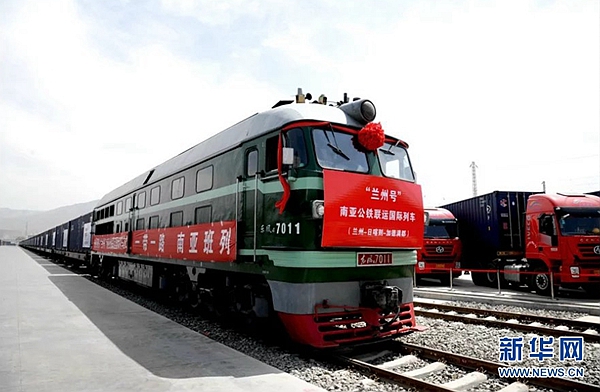Belt and Road
Your Present Location: PROGRAMS> Belt and RoadBRI aspirations in Nepal
Source: China.org.cn Published: 2017-7-10

China opens its first combined transport service to Nepal on May 11, 2016. [Xinhua]
On May 12, 2016, China`s People’s Daily managed to find a small, yet strategically important space for a brief article with four photographs. These were related to a freight train with 86 cargo containers, waiting at a station in Lanzhou, northwestern China, poised for a journey to the Nepalese capital of Kathmandu.
The byline story by Liang Jun entitled “China opens its first combined transport service to Nepal,” stated the international freight train would travel within Chinese territory to the current railhead of Xigaze (Shigatse) in Tibet, and then the freight would be carried by road via the Gyirong (Kerung) border post of Nepal. The whole journey to Kathmandu takes 10 days at present.
The social media users in Nepal welcomed the news with great enthusiasm and started trending on Twitter. The media, especially vernacular online outlets, presented the news as if the train would travel straight to Kathmandu on railway lines produced almost by magic.
Response to the news was quite idealistic, reflecting the hope and a level of trust of Nepalese towards its northern neighbor as a savior (following India`s economic embargo on Nepal).
Nepalese always look north when there is any bullying from the south (India), so that the Chinese freight trains became a symbol of hope for a people suffering from the six-month Indian blockade.
Road links between China and Nepal have always been problematic given the adverse geographic terrain.
Nepal is now part of the Belt and Road Initiative (BRI) proposed by Chinese President Xi Jinping. Before signing in the BRI framework, Nepal`s former Prime Minister Puspa Kamal Dahal “Prachanda” faced close questioning at home about how much trust should be placed on China and overall Sino-Nepal cooperation.
Pro-Indian intellectuals prodded the government to avoid the BRI to appease India. However, such suggestions were ignored as the Dahal-led government finally signing the BRI framework. Prachanda, as befitting the leader of a Maoist party, remains the only prime minister to choose Beijing for his maiden foreign trip instead of New Delhi.
In this context, a prominent foreign affairs analyst in Nepal, Dr. Arun Kumar Subedi, says: "It was not an easy job for Prachanda to take the decision in view of India’s serious reservations over Belt & Road Initiative mainly on two points. First is concern over the China-Pakistan road link and the second is the likely railway link connecting China and Nepal, creating a trade deficit with the Chinese."
Dr. Subedi believes it is now up to China to act on behalf of Nepal in convincing India.
The Indian concern is nothing mysterious. The Lanzhou freight train`s horn became so loud that it was heard all over India. Some former Indian diplomats hurried to highlight the adversity aspect in regard to the Nepal-China border and negative prospect of rail links being developed.
One Indian media outlet even went so far as to fabricate a story that the “train contained weapons from China as Nepal was seeking to lessen [the latter’s] trade dependency on India.”
These Chinese/Indian media stories and responses in Nepal reflect the reality of strategic sensitivity of Nepal`s position between the two Asian giants. At the same time, Nepal`s aspiration towards China is as savior. Indian media have always been very shallow in the way they deal with many serious issues including the foreign relations.
There is a stable base structure in the Nepalese psyche towards China as the most trustworthy neighbor in need. The decade-long careful diplomacy from the northern side has enhanced this perception, but there have been some disturbing recent trends.
For instance, it has been observed that some Chinese media outlets and scholars are vocal especially in regard to some leading figures in Nepal. Some media even try to `brand` Nepali leaders either as “pro-Chinese” and “pro-Indian” or vice-versa.
In many ways, this matches the old fashioned Indian media strategy in terms of Nepalese affairs. When a change of government occurs, Indian media rush to tag the elected Prime Minister either as pro- or anti-India.
This defaming model has been a “failure” strategy of Indian media in dealing with Nepal. If Chinese editors start following the same notorious path, it could result in hate and distrust, which easy to reach but hard to escape from.
Cordial bonds between immediate neighbors are rare across the globe. However, the Sino-Nepal relations remain exception to this. In comparison to the Indo-Nepal relations, the Sino-Nepalese relationship enjoys a comfortable level of trust at both the state-to-state and peoples-to-people level.
This stems heavily from the fact that China follows a policy of non-interference in Nepal`s internal politics.
Despite China being a rapidly-rising economy in the world, Nepal lags well behind in the development of physical infrastructure. After signing on the Belt & Road Initiative Nepalese people have started seeing China as a permanent development partner. And this sentiment seems to have been shared by Chinese side as well.
Dr. Chen Xiaochen, a researcher at Chongyang Institute for Financial Studies in Remnin University of China, has stated: “As a growing economy China is willing to support Nepal in infrastructure development by sharing Chinese experiences as a developing country.”
Chen Xiaochen is director of the International Studies Department at Chongyang Institute for Financial Studies, Renmin University of China.
Key Words: Nepal;China;infrastructure;Chen Xiaochen























































































 京公网安备 11010802037854号
京公网安备 11010802037854号





